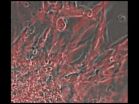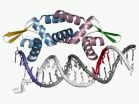(Press-News.org) A gene known to repair DNA damage in healthy cells may also provide new insights about treating a genetic disorder of the bone marrow, Caltech researchers say.
This finding was published in the May 15 print edition of the journal Cell Cycle.
In the study led by Judith Campbell, professor of chemistry and biology at Caltech, the researchers investigated the relationship between two genes—FANCD2 and DNA2—both known to play roles in fixing broken or damaged strands of DNA within a cell, called DNA repair. A defective version of the FANCD2 gene can result in the genetic disease Fanconi anemia (FA), which is characterized by failure of the bone marrow (an inability to replenish the body's supply of blood cells) and a predisposition to certain developmental disorders and cancers. Although DNA2 has not been associated with an FA family as yet, genetic studies implicate DNA2 in the FA DNA repair pathway.
To determine the relationship between the genes, the researchers applied formaldehyde and other DNA-damaging substances to three types of cells: those lacking FANCD2, those lacking DNA2, and cells lacking both FANCD2 and DNA2. The groups of cells in which only one of the two genes had been deleted quickly succumbed to the formaldehyde-induced DNA damage; however, the cells lacking both FANCD2 and DNA2 were able to repair the DNA damage and survive.
"A key implication of this finding is the potential to manipulate DNA2 to improve the survival of FANCD2-deficient cells, and hopefully, by extension, the survival of FA patients," says Kenneth Karanja, a former postdoctoral scholar in Campbell's laboratory and first author on the study. Currently, the only treatment for FA is a bone marrow transplant, but even after the transplant the disease remains lethal.
"DNA2 is a well-studied gene, and this recent discovery could potentially become the basis for ameliorating the symptoms of this incurable disorder," Campbell says. Furthermore, she says, the protein DNA2 encodes is a nuclease—which is a specific type of enzyme that has become a promising drug target.
"Since much is known about the mechanism of action of DNA2, it is an attractive target for future drug treatments—like small-molecule inhibitors that could reduce an FA patient's cancer predisposition—as well as a possible gene therapy for aiding a patient's blood cell development," she says.
INFORMATION:
The work was published in a paper titled: "Preventing over-resection by DNA2 helicase/nuclease suppresses repair defects in Fanconi anemia cells," available at https://www.landesbioscience.com/journals/cc/article/28476/. The study was funded with support from a Breast Cancer grant from the Congressionally Directed Medical Research Programs, the Ellison Foundation, and a Ross Fellowship from the Caltech division of Biology and Biological Engineering.
In addition to the cell cycle and cell division, Cell Cycle covers all topics from man to virus, from DNA to RNA, from aging to development, from cell senescence to stem cells, from apoptosis to autophagy, from cancer to neurobiology, from molecular and theoretical biology to medicine and therapy. Established in 1997, Landes Bioscience is an Austin, Texas-based publisher of biology research journals and books. For more information on Landes Bioscience, please visit http://www.landesbioscience.com/.
DNA repair gene provides new ideas for disease treatment
2014-04-30
ELSE PRESS RELEASES FROM THIS DATE:
Watch out: Children more prone to looking but not seeing
2014-04-30
Children under 14 are more likely than adults to be 'blinded' to their surroundings when focusing on simple things, finds a new UCL study. It explains a somewhat frustrating experience familiar to many parents and carers: young children fail to notice their carer trying to get their attention because they have little capacity to spot things outside their area of focus.
The findings suggest that even something simple like looking at a loose thread on a jumper or an advert on the side of a bus might be enough to make children 'blind' to oncoming traffic and other dangers ...
Discovery of anti-appetite molecule released by fiber could help tackle obesity
2014-04-30
New research has helped unpick a long-standing mystery about how dietary fibre supresses appetite.
In a study led by Imperial College London and the Medical Research Council (MRC), an international team of researchers identified an anti-appetite molecule called acetate that is naturally released when we digest fibre in the gut. Once released, the acetate is transported to the brain where it produces a signal to tell us to stop eating.
The research, published in Nature Communications, confirms the natural benefits of increasing the amount of fibre in our diets to ...
Mouse study points to potentially powerful tool for treating damaged hearts
2014-04-30
VIDEO:
This shows heart tissue grown in a dish from mouse cardiac progenitor cells (CPCs). The CPCs, and the tissue they built, were engineered to produce a red protein.
Click here for more information.
A type of cell that builds mouse hearts can renew itself, Johns Hopkins researchers report. They say the discovery, which likely applies to such cells in humans as well, may pave the way to using them to repair hearts damaged by disease — or even grow new heart tissue for transplantation. ...
Suomi NPP satellite sees clouds filling Tropical Storm Tapah's eye
2014-04-30
NASA-NOAA's Suomi NPP passed over Tapah and captured a visible image of the storm that gave a hint of weakening as clouds began to fill its eye. On April 30 at 0900 UTC/5 a.m. EDT, Tropical Storm Tapah continued to weaken as wind shear began to increase and the storm moved toward cooler waters in the Northwestern Pacific Ocean.
NASA-NOAA's Suomi NPP satellite passed over Tropical Storm Tapah on April 30 and the VIIRS instrument aboard captured a visible image of the storm as it weakened from a typhoon to a tropical storm. The imagery showed that Tapah's eye was becoming ...
New experimental vaccine produces immune response against MERS virus
2014-04-30
The University of Maryland School of Medicine (UM SOM) and Novavax, Inc. (NASDAQ: NVAX) today announced that an investigational vaccine candidate developed by Novavax against the recently emerged Middle East Respiratory Syndrome Coronavirus (MERS-CoV) blocked infection in laboratory studies. UM SOM and Novavax also reported that a vaccine candidate against Severe Acute Respiratory Syndrome Coronavirus (SARS-CoV) developed by Novavax on a similar platform also inhibited virus infection. Researchers reported these findings in an article published in the April 13, 2014 issue ...
Whey beneficially affects diabetes and cardiovascular disease risk factors in obese adults
2014-04-30
New evidence shores up findings that whey protein, which is found in milk and cheese, could have health benefits for people who are obese and do not yet have diabetes. The study, which appears in ACS' Journal of Proteome Research, examined how different protein sources affect metabolism.
Lars O. Dragsted, Kjeld Hermansen and colleagues point out that obesity continues to be a major public health problem worldwide. In the U.S. alone, about 35 percent of adults and about 17 percent of children are obese, a condition that can lead to a number of health issues, including ...
SDSC resources, expertise used in genomic analysis of 115 year-old woman
2014-04-30
A team of researchers investigating the genome of a healthy supercentenarian since 2011 has found many somatic mutations – permanent changes in cells other than reproductive ones – that arose during the woman's lifetime. Led by Erik Sistermans and Henne Holstege from the VU University Medical Center in Amsterdam, the team recently published its findings in the journal Genome Research as reported by GenomeWeb.
While previous studies have examined mutations that arise in certain disease conditions such as leukemia, Sistermans said that it was not well known how many mutations ...
N-glycan remodeling on glucagon receptor is an effector of nutrient-sensing by HBP
2014-04-30
TORONTO -- A possible therapeutic target for control of blood glucose in the treatment of type 2 diabetes and obesity has been identified by Dr. Anita Johswich and her colleagues. Their findings were published in Journal of Biological Chemistry, online April 17, 2014.
An imbalance in the competing action of insulin and glucagon is widely viewed as a critical factor in onset of type 2 diabetes, a relentlessly increasing health problem. A delicate balance between two hormones controls blood glucose levels day and night. After a meal, blood glucose rises, which stimulates ...
A protein key to the next green revolution sits for its portrait
2014-04-30
If you pull up a soybean or bean plant and shake off the dirt, you might see odd swellings or bumps, like rheumatic finger joints, on its roots. Inside the cool, soil-covered bumps are bacteria that are making nitrogen with the help of an enzyme, something chemical factories can do only with the help of a catalyst and at high temperature and pressure.
The bacteria, typically members of the genus Rhizobia, break the strong triple bond between the nitrogen molecules in the air and repackage the nitrogen atoms in chemical compounds the plant can use. In return, the plant ...
'Charismatic' organisms still dominating genomics research
2014-04-30
Decades after the genomics revolution, half of known eukaryote lineages still remain unstudied at the genomic level--with the field displaying a research bias against 'less popular', but potentially genetically rich, single-cell organisms.
This lack of microbial representation leaves a world of untapped genetic potential undiscovered, according to an exhaustive survey conducted by UBC researchers of on-going genomics projects. The survey results are published in the May issue of Trends in Ecology and Evolution.
"We're still mostly analyzing the same well-known eukaryotic ...


